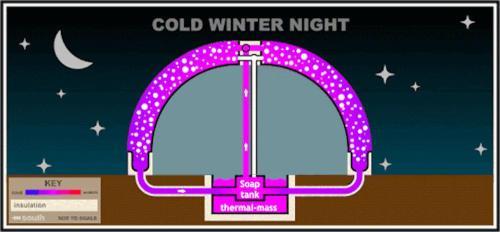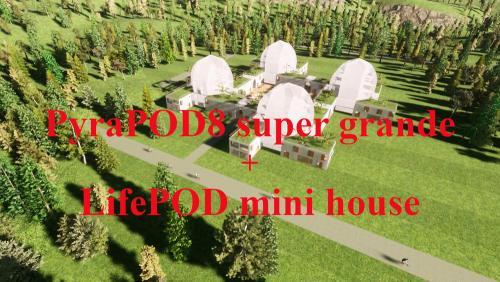


MoonShadows said:Hi Aubrey @pyrapod and welcome to the forum
This is the first I have ever heard of the SolaRoof/PyraPOD greenhouse model. I am surprised with all the reading/research I have done on greenhouses, I have never seen this. I briefly looked at your website, and I did recognize and remotely remember reading at some point about Richard and seeing that picture of the plant still thriving since 1960 in a completely sealed glass vessel. I did not see, except for that photo (screen shot), any other photos/videos other than simulated renditions. Perhaps I missed them. I will have to spend more time on your website. Do you have any other pictures/videos of a real-life example(s)?
Jim
binfordw said:Soap, hmm. sounds messy to me!
I'd be curious to see a real world version of any scale as well.
pyrapod said:Remember, building a greenhouse without using soap bubble foam is a waste of money and effort. Once you use the wet foam, then the magic happens. Period.
I would think magic would sell itself better! Looks like the soap bubble insulation idea has been around for quite awhile from articles I've found on the web, must be a reason it hasn't gained any ground yet?
MoonShadows said:Hi Aubrey,
Thanks for the reply, and I looked at your post. It looks like your numbers/charts reflect what you are saying, but what I was looking for is a video demonstration of a real world soap-bubble greenhouse and how it functions. The soap/water reservoir, the mechanics...a soap bubble greenhouse in action.
How is it that this concept has been "hidden" for so long? What would be the cost for a homeowner for one of these systems...within the common sizes for a backyard greenhouse? Or, would the cost only make sense for a commercial scale greenhouse? I know you said it would be expensive initially, but cheaper in the long run because of the temperature effects and energy savings, but how much money are we talking? There are many splendid ideas and solutions for many of the problems in the world that never come to fruition because of the costs involved. Would this greenhouse be marketable or prohibitively expensive for the common backyard greenhouse grower?
BruceM2 said:Soap bubble insulation has been proven, but when done side to side with reflective insulating curtains, it was not substantially better. Which tells me that the end wall and earth losses are a bigger portion of the total thermal loss than i would have expected. So it's a lot like building a super-insulated home; you must address ALL the losses.
[url=file:///C:/Users/Bruce/AppData/Local/Temp/69-1644-15-03_Final_Report_Use_of_Soap_Bubble_Insulation_in_Greenhouses.pdf]file:///C:/Users/Bruce/AppData...[/url]
So I do think soap bubble insulation could be a good way to eliminate the mechanical and electro-mechanical issues of moveable insulating panels. Soap bubble systems do introduce their own maintenance and reliability issues.
In my own testing, I found that I was able to easily produce an 8 foot column of fine bubbles rising from a 5 gallon bucket by feeding compressed air to a coil of recycled rubber weep hose in the bottom of the bucket, with the bucket half filled with bubble solution (water, detergent). This eliminates the requirement for overhead active plumbing and blowers, and since it's simpler and better contained, even toxic glycol antifreeze could be used in the bubble mix. An insulated trough lined with pond liner would hold the solution.
For my test, I was using about 35 psi from my shop air compressor but I'm sure lower pressure could be used (such as a shop vac or leaf blower motor) with the right perforated air emitter.
One of the annoying things about soap bubble insulation is that a great deal of thickness is required, and the degradation of plastic/film over time from the solution and UV breakdown of the solution residue. The R value is estimated by different sources between 0.5 to 1 per inch. The original Canadian greenhouse application used 30 inch spacing.
I'd love to see a commercially available, well designed home/hobby greenhouse with a soap bubble insulation system!
DaisyI said:pyrapod
In your first post you said: "We encourage DIY projects. By reading info and watching videos on our site, most handy men and women can replicate easily."
In your last post: "He has been doing this for 40 years and he knows all about it including little secrets that no one will get it right even if they can replicate some aspects of the technology."
I want to see up and running greenhouses, not drawings, graphs and theories. I suspect if this was a viable option, after 40 years there would be "bubble" greenhouses all over the planet. The one thing I don't think anyone has mentioned is light permeability.
BruceM2, thank you for your most comprehensive unbiased report on this concept.
pyrapod said:
DaisyI, there are two kinds of replications: (1) you watch videos and presentations and then you say, ah, I have got it and you start replicating. (2) you do one more step further by asking questions and fully understand how it works. That is the difference between surface understanding and deep understanding. Just like everyone knows cooking and its theory, but not everyone is a good cook.
As long as you spay water in the double layer cavity, you will get better result than the single layer or double layer greenhouse filled with air only, especially in the summer time when overheating is a major problem for any greenhouses - that is why ventilation is a must. But since spraying water only works in summer time, we need to fill the cavity with bubbles. Why? To insulate so that we do not loose the heat collected during the day. As simple as that. It is crystal clear. But still, you know what I mean.
Concerning your last paragraph, I have tried to answer it on the website in the FAQ section. I bet you do not care as you are like many doubting Thomas out there, doubting about it in the first place. If everyone doubts without taking any actions, then no one will make it happen.
Like many other good things other there, the power elites tend to suppress them because they do not want us to use them. That explains why it takes so long for such a wonderful and simple invention to be presented here. It will take even longer time to have it realized if I do not take the action.
Again, whoever takes the action will benefit right away and the most.
BruceM2 said:Getting some prototypes built and out there, and collecting good data on performance in a wide range of conditions would seem to be an important first step that is completely missing so far.
DaisyI said:
Thank you! Perfect answer. Only people trying to hide something need to insult and attack rather than explain. I am excited to know I am part of the "power elite" but disappointed you think I'm a bad cook.You are the one who needs to take action by actually building a greenhouse using your FAQ, figures and graphs. I don't need to prove your theories for you. Really, the only question I asked was about light permeability.
Once again, thank you Bruce.
pyrapod said:
I am mad at those who know it is working and still try to hide things so that we the people cannot benefit from this.
DaisyI said:
This thread gets funnier and funnier! I'm sure there is a giant conspiracy (led by me) to keep people from all over the world from building whatever they want, especially if it concerns bubbles
I really doubt your 95% transmission number. My greenhouse has 5 wall polycarbonate, its light transmission is 65%. Double glazed window glass is about 70%. Light transmissivity of bubbles as seen in your many diagrams would be extraordinary low as the bubble size is small. You can see through one bubble but pile them up and you see less. The thicker the bubble stack, the less light going through.
I also have major concerns about your claim that your greenhouse would never need ventilation. Just by logic, damp soil and green respirating plants make damp air. Its called humidity. The more dampness the higher the humidity. Then add still air - still damp air equals mold and fungus.
That's before you get to the carbon dioxide problem. If you have a really well sealed greenhouse, you will have to add a source of carbon dioxide or your plants will stall out. I could go inside and breathe deeply everyday - my own oxygen bar.
As they say in 'Shark Tank'... I'm out.
